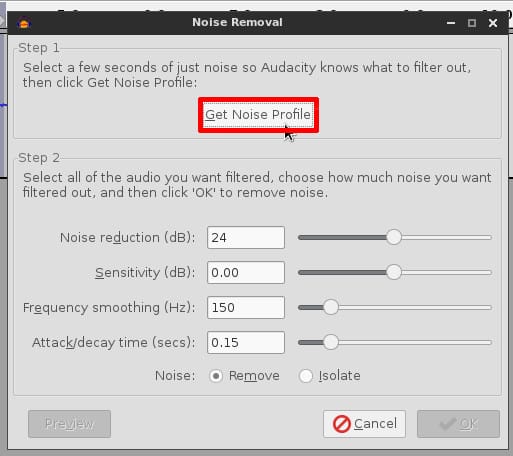
A general-purpose mic won't pick up quiet instruments or subtle sounds, so make sure to get a microphone suitable for your needs. Make sure that the mains electrical cables are not running across any audio cables like your headphone wires, because the electromagnetic force which surrounds mains cabling can cause interference.Switch off anything noisy, like ceiling fans, televisions and so on.
 Check for nearby devices which might cause interference. Move the dial up and down until you find the right balance of sound volume and background noise. Check the box marked Use ambient noise reduction.
Check for nearby devices which might cause interference. Move the dial up and down until you find the right balance of sound volume and background noise. Check the box marked Use ambient noise reduction.  Find Sound preferences and look for the Ambient Noise Reduction tool. Go to Listen to this device, then click OK. To test the noise, go back to the Recording menu. If they aren't already ticked, tick the following boxes: Noise suppression and Acoustic echo cancellation. Next, go to the tab marked Enhancements. Move the dial all the way up on the Microphone. Move the dial all the way down on the Microphone boost. Find the Levels tab, and look for the Microphone Boost tool. Right-click on the Microphone bar, and then select Properties. This is how to minimise background noise on laptop recordings. Follow the steps below for tips on how to minimise background noise from an audio recording. To some extent, any sound recording will generate background noise, but there's a lot that you can do to minimise interference.
Find Sound preferences and look for the Ambient Noise Reduction tool. Go to Listen to this device, then click OK. To test the noise, go back to the Recording menu. If they aren't already ticked, tick the following boxes: Noise suppression and Acoustic echo cancellation. Next, go to the tab marked Enhancements. Move the dial all the way up on the Microphone. Move the dial all the way down on the Microphone boost. Find the Levels tab, and look for the Microphone Boost tool. Right-click on the Microphone bar, and then select Properties. This is how to minimise background noise on laptop recordings. Follow the steps below for tips on how to minimise background noise from an audio recording. To some extent, any sound recording will generate background noise, but there's a lot that you can do to minimise interference. 
Background or 'ambient' microphone noise can be a real pain, but there are tricks to help reduce it.







 0 kommentar(er)
0 kommentar(er)
